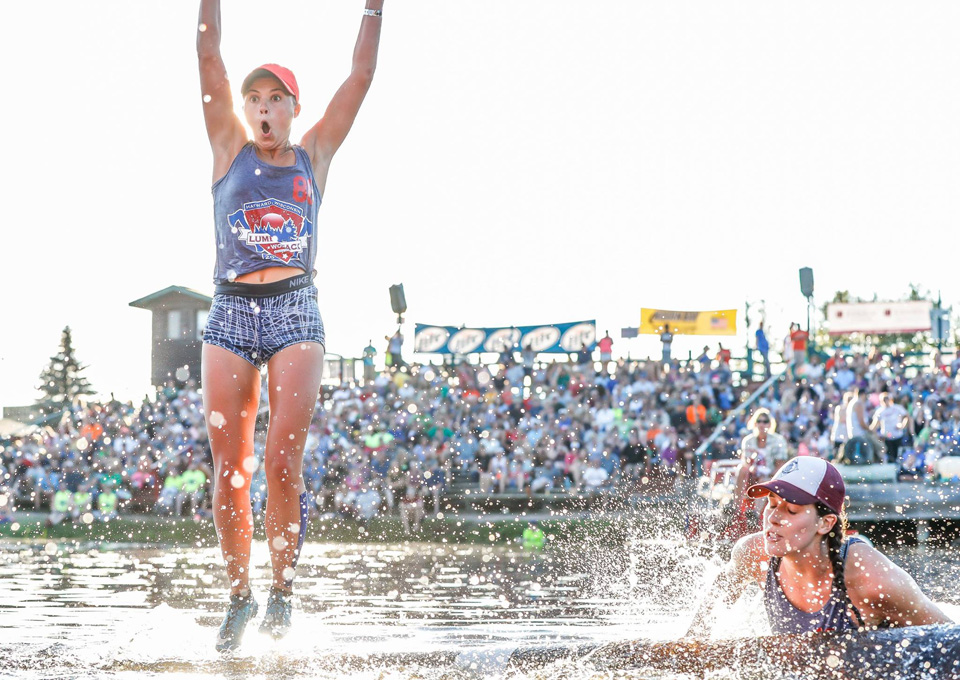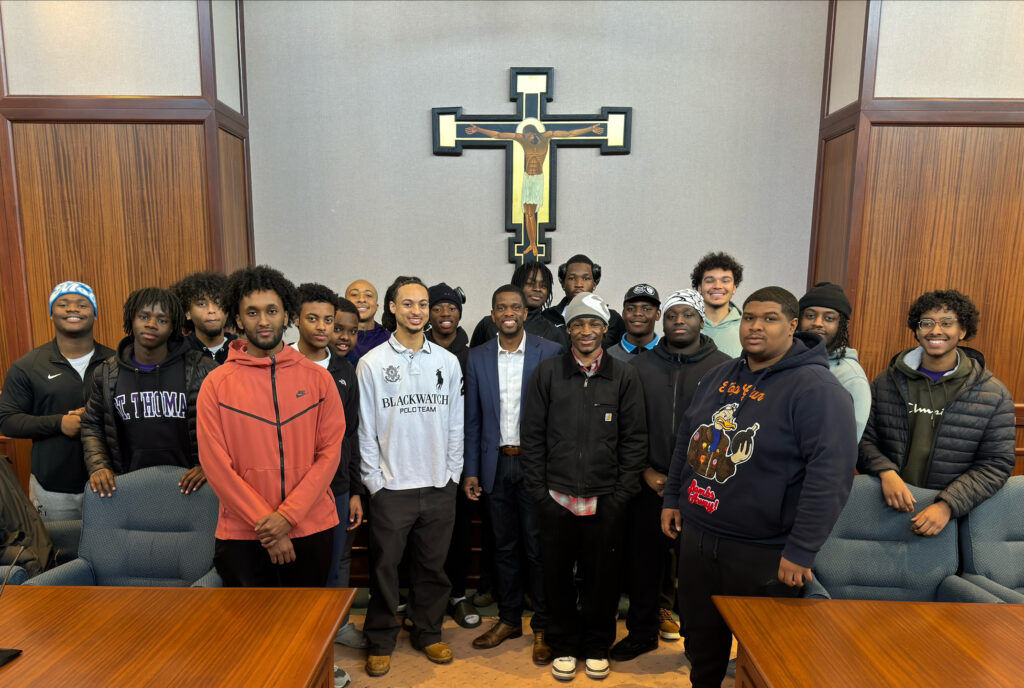Like most University of St. Thomas students, junior Ellie Davenport is very busy. A newly minted elementary education major after switching from biology, she wrapped up her first academic year at St. Thomas in May. (Davenport earned college credit as a PSEO student her junior and senior years in high school.)
In addition to prepping for finals, however, Davenport had one more noteworthy commitment on her plate: She had a world title to defend.
This July, Davenport returned to Hayward, Wisconsin, where in 2016 she was world champion in the women’s world log rolling at the Lumberjack World Championships, also known as the “Olympics of the forest.”
In her ascent to the top of women’s professional log rolling, Davenport could have had her pick of excuses to get out of training, to quit or to not pick up the sport in the first place. Her potential obstacles ran the gamut: her late start in the sport (log rollers with ambitions of going professional often have family ties and begin their training at age 6 or 7 under the guidance of their experienced parents); her youth and petite stature in a field of older, more experienced, more brawny competitors; and a “horrible” first season as a professional at 15.
Her most formidable obstacle, however, is one she could not pep talk or train herself out of: Davenport was diagnosed with scoliosis at 13. Shortly after, she was captivated by the sight of two rollers in the YMCA pool near her home in Hudson, Wisconsin. Instead of finding excuses, the St. Thomas junior found a way through.
(Log) rolling with it
“Log rolling and scoliosis are the two biggest things that have shaped my life,” Davenport said.
When she was in eighth grade, her mother noticed her daughter’s back didn’t seem quite right when she bent down to pick something up. A trip to the doctor revealed she had a serious case of scoliosis. Davenport was required to wear a custom-cast back brace 23/7 and, for more than three years, she trained in the one hour per day she could shed her brace.
Though she learned to have a sense of humor about the sudden intrusion in her life – “I nicknamed my brace my ‘abs of steel,’” she said – the ensuing years brought many tears and bouts of frustration.
“Wearing a body brace in middle school was a huge blow, physically and emotionally. It's a hard time in life for everyone,” Davenport’s mother, Joan, said. “But Ellie made some hard choices about how she was going to feel about having scoliosis, wearing a brace, and had to answer the question, ‘Is scoliosis going to define who I am?’ It was a heart-wrenching process to watch. In true Ellie style, she chose to focus on what she could control, to share her struggles publicly, and stay positive. Log rolling became her escape from the brace, and she used every minute to improve her skills, both mentally and physically.”
Davenport committed to training through her condition as she climbed the log rolling ranks, even wearing it faithfully on a hot mission trip to Mexico while a student at St. Croix Preparatory Academy in Stillwater, Minnesota.
“It was hard to go from log rolling, which is all about balance, to wearing my brace and not being able to tie my shoes,” she said. “Plus I’d get heatstroke all the time and I had to wear seamless shirts underneath it or my skin would chafe.”
Davenport was equally driven outside of rolling. Around the time she went pro at 15, she began taking classes at nearby Century College as a PSEO student. She enrolled in the PSEO program full time as a senior, maintaining a 3.9 GPA, and returned to St. Croix Prep after her last class each day to co-captain the track team and participate in soccer practice.
"‘Is scoliosis going to define who I am?’ ... In true Ellie style, she chose to focus on what she could control, to share her struggles publicly, and stay positive." - Joan Davenport
Roleos, explained
A log rolling competition, called a roleo, is a game of balance, coordination, concentration and strategy between two competitors. The rollers, who wear shoes modified with 22 golf spikes, do whatever they can to remain on the log and cause their opponent to fall. The only two rules are to not cross the center line and to not touch their opponent.
“Pro is a whole new level,” Davenport said. “Mental games come into play. … Some rollers even wear neon shoelaces to make their opponents’ eyes burn!”
Rollers compete to win three out of five “falls” on 12-foot logs that range in diameter from 11 to 14 inches. The pinnacle event is the Lumberjack World Championships. Pro-level rollers also compete in the boom run, a race in which two competitors race across a chain of floating logs. Davenport is ranked second nationally and fourth in the world in the boom run.
"My first year [as a pro] I got beat bad but it got me fired up and I made the finals my second year," Davenport said. Her efforts, however, paid off, and in 2015, of the seven tournaments she competed in, she won five, taking second in the other two.
In "true Ellie style" she again found a way to take one of those losses – in the final at the world championship, "in front of 2,000 people” she recalled with a cringe – and turn it into a catalyst for diving deeper into her well of strength.
“When I fell, I remember thinking, ‘Did I just lose?’” she said. “I took it hard because I didn’t roll my best. I was surprised by her (opponent Meredith Ingbretson’s) tactics, so I worked at mastering all the styles after that.”
St. Thomas gets involved
Dr. Brett Bruininks, a professor in St. Thomas’ Health and Human Performance Department, is leading the early stages of a collaborative project that will include students and faculty in HHP and the School of Engineering. Though it’s in the cocktail-napkin sketch phase, with drawing credit going to Bruininks, he has envisioned a portable log-rolling simulation device that will allow Davenport to train out of water year round.
Bruininks has worked with power lifters and Strongmen competitors, but never has St. Thomas had an opportunity to work with a professional log roller, he said.
“This is a great opportunity to be innovative on a truly unique project,” he said. “Health and human performance students will be collaborating with engineering students, so we’ll have the fitness and training component working with the know-how engineering and computer science components on the structural side.”
Plans include taking a real log similar to the size used in roleos and developing software that will allow it to replicate how a log spins and moves in water, and how Davenport moves in competition. He imagines it would be suspended about a foot from the floor, surrounded by mats for cushion.
“Health and human performance students will be collaborating with engineering students, so we’ll have the fitness and training component working with the know-how engineering and computer science components on the structural side.” - Assistant professor Brett Bruininks
The team also will look to the real expert – Davenport – for help.
“A lot of this will be up to how she wants to attack this sport,” Bruininks said. “We’ll pick her brain on the best possible feeling as we move through development.”
At 5’2” and 110 pounds, Davenport is used to being the smallest roller among the pros, which starkly affects her strategy and dictates to an extent the way she must roll, so she is enthusiastic to help out any way she can.
Although she mainly reacts to her competitors movements, she has trained herself to capitalize on their “missteps and uncertainties.”
“People who weigh more have the advantage because they control the forward and backward motion,” Davenport said.
Defending champ
In the past, competitors may have underestimated the diminutive Davenport. Not anymore. Now she is the one with the X on her back.
In the seven years since she began rolling, she’s beaten all of her mentors and brawnier competitors, except one: a seasoned roller with “a six pack on top of her six pack,” she said. Though the amity between her competition is warm and good-natured, when asked if she’s gunning to “fall” this particular fellow roller, she eagerly chimed, “Oh yeah!”
While Davenport had to settle for third place this year at the World Championships, she has remained ranked number one in the world all year based on her overall performances: Beyond not finishing outside the top three in any event, she also won this year's United States Open in Chicago and the Midwest Log Rolling Championship.
To read more about Davenport's life with scoliosis, visit her website, gotscoliosis.com, which she created to inspire other children and teens with scoliosis to not let their condition hold them back from their goals.







